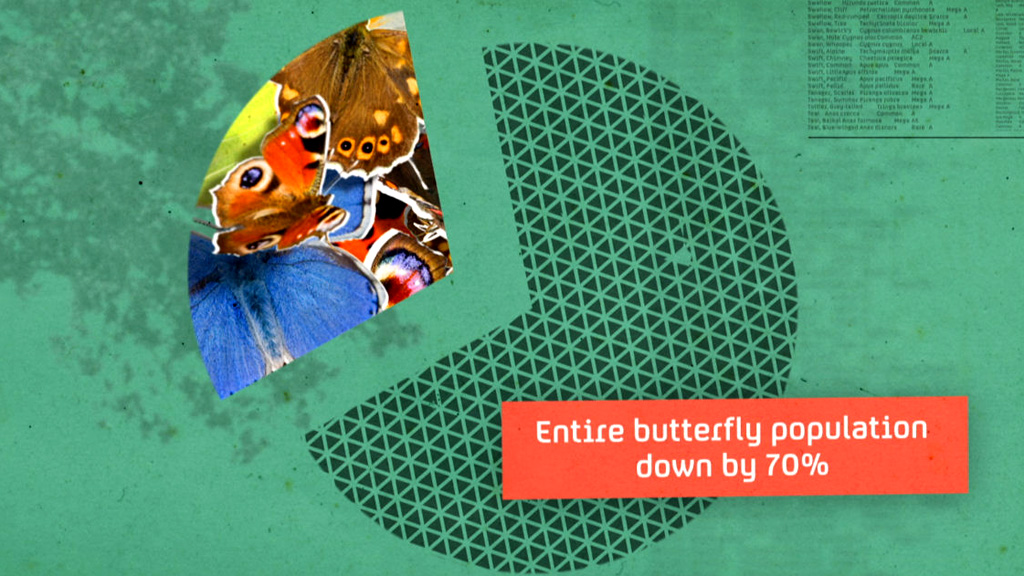Britain’s best-loved species in terminal decline?
The British countryside is facing unprecedented change with “wildlife in crisis”. In a special series – Green and Pleasant Land – Channel 4 News finds iconic species and habitats facing wipeout.

The sweeping sky full of skylarks, the swirling of thousands of starlings, the coos of turtle doves through the air, the fluttering of butterflies across the wildflower meadows. It is a world I have never fully experienced, and so never realised I missed, writes reporter Rachel Seifert.
And then I embarked on this journey for Channel 4 News to discover what is happening across Britain, and found that even within just my lifetime the decline has been astonishing – and happening in front of my eyes.
I know about the near extinction of some of the world’s great species, like the tiger, and the rapid felling of the tropical rainforests, the melting of the arctic icecaps. But what I did not realise is that similar changes to our own wildlife and landscape are happening here and now – right on our own doorstep.
“Our wildlife is in crisis,” according to the head of the RSPB, Martin Harper, the UK’s biggest wildlife conservation charity – and the latest figures show a world in freefall. In just a few decades, we’ve lost 44 million birds from our skies, with some species plummeting as much as 90 per cent and facing a very real extinction.
Over 70 per cent of our butterfly species are in decline, as well as our bugs and insects on which our whole ecosystem depends, with only 2 per cent of our wildflower meadows still remaining. And the hedgehog is facing the same rapid decline as the tiger, dropping from 36 million in 1950 to just 1 million today.
These are breathtaking figures and a new report from 40 top environmental scientists is a wake-up call showing us that the Britain that we know and love is in flux, with changes to our much-loved countryside taking place at an unprecedented rate. Travelling across Britain, I witnessed some of our most treasured habitats under threat.
Read the Living with Environmental Change Biodiversity report here.
Standing on the mountain tops in the middle of Scotland, a place more breathtaking than many of the more exotic places I have seen on my travels, I saw for myself how it is not only the arctic ice which is melting, but our Scottish snow beds.
This is pushing the tree line higher, the vegetation up the hills, and with them the specialist montane birds which are rapidly being lost on the lower slopes as they are moving further and further up the mountain to keep within their climatic zones. I was faced with the stark realisation that these birds would soon simply have nowhere to go. With 25 per cent of all British species under threat based in Scotland, there is a real concern that the rate of change will cause the loss of some of our most iconic habitats.

Springtime out of sync
These changes are also being seen on our coastline, the habitat which defines us as an island and provides breeding grounds for internationally important seabird colonies.
In the Farne Islands, off the coast of Northumberland, I saw first-hand the effects of the last 12 months of extreme weather. The lengthy harsh winter, with the coldest March on record for 50 years, saw the worst seabird wrecks for decades, with thousands of dead malnourished puffins and shags washed up on shore.
The shag population was decimated, with a 60 per cent decline in numbers, and the puffins were already struggling due to the unseasonably wet Spring last year which flooded 90 per cent of their burrows.
Orchids are not flowering at the right time for their pollinators, birds are not nesting when the caterpillars that they feed on are out, and hedgehogs and bats are coming out of hibernation at the wrong time of year.
With more extreme weather predicted, there are only so many bad seasons these creatures can take before their populations are laid waste, and these wonderful sights around the British coastline are a thing of the past.
But travelling across our green and pleasant countryside, one of the most shocking realisations was how the perfect harmony of our natural world is starting to unravel. Orchids are not flowering at the right time for their pollinators, birds are not nesting when the caterpillars that they feed on are out, and hedgehogs and bats are coming out of hibernation at the wrong time of year. With our temperate and defined four seasons becoming more like two extremes, the synchrony of our ecosystem is collapsing and its natural processes and cycles slowly being pulled apart.
We often take for granted the fact that we rely on the natural world and a carefully-balanced ecosystem. Not only is the decline of iconic species and habitats a real loss for our culture and identity, but it is also a serious wake-up call to us as humans. The stark realisation is that this is happening here and now – in our lifetimes.
-
Latest news
-
Post Office scandal: workers react to ex-CEO Vennells at inquiry4m

-
Election 2024: what voters think of Rishi Sunak announcement3m

-
Post Office inquiry: former boss Vennells admits evidence was false5m

-
‘We are going after every vote we possibly can’, says deputy leader of Liberal Democrats4m

-
What’s the mood in Wales for an early general election?7m

-




